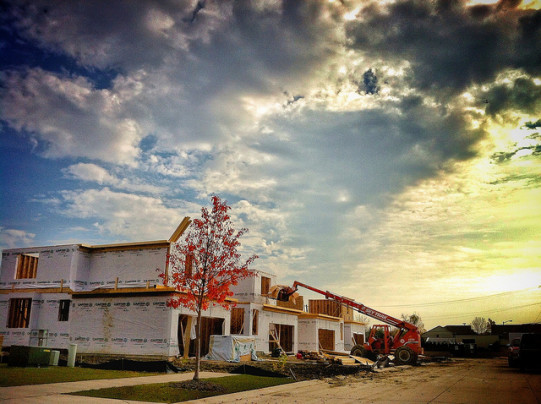Homes for sale are selling more quickly this year than they were at the same time last year, according to a new analysis. The data, collected by Trulia, looked at the number of homes listed for sale on February 5 and tracked how many of those homes were still for sale on April 5. The results found that, nationally, 60 percent of the homes for sale in February were still on the market in April. That’s a 2 percent drop from last year. The quickening pace is a reflection of the number of homes available for sale. In markets where inventory is tight, sellers are able to find interested buyers more quickly, while areas with more inventory and fewer buyers will typically see available homes lingering on the market for longer periods of time. That means, prospective home buyers will have to be prepared to make a move more quickly in regions where homes spend less time on the market. The data also reveals that, though the pace of home sales will vary greatly from one local market to the next, housing markets in the West are generally moving more quickly than those in the Northeast. In fact, eight of the fastest moving housing markets were in California. Also in the report, lower priced homes are selling faster than higher priced homes. Among lower-priced homes, 50 percent were still on the market after two months, compared with 65 percent of higher-priced homes. More here.
Archive for April 2015
Home Builders See Brighter Days Ahead
The National Association of Home Builders’ Housing Market Index measures home builders’ confidence in the market for newly built single-family homes. The survey, which has been conducted for the past 30 years, gauges perception of the market on a scale where any number above 50 indicates more builders view conditions as good than poor. In April, the index rose four points to 56. Tom Woods, NAHB’s chairman, said the increase is an indication that builders see conditions improving. “As the spring buying season gets underway, home builders are confident that current low interest rates and continued job growth will draw consumers to the market,” Woods said. In fact, builders seem most optimistic about the months ahead. For example, the component of the index measuring sales expectations for the next six months saw the biggest gains, jumping five points to 64 – the highest level yet this year. Components gauging current sales conditions and buyer traffic were also up from the month before. Regionally, three-month moving averages reveal that the South, West, and Midwest all remain above 50, while the Northeast trails behind at 42. More here.
New Home Construction Rises In March
Estimates released by the U.S. Census Bureau and the Department of Housing and Urban Development show the number of new homes that began construction in March was 2 percent higher than the month before. The improvement included a 4.4 percent increase in single-family housing starts, as opposed to multi-family units, but was still below most economists’ expectations. In fact, economists predicted construction would rise to an annual rate of 1.04 million homes but the numbers show a projected rate of just 908,000. Still, low mortgage rates and consistent job growth have analysts optimistic that new home construction will continue to improve, as housing grows stronger and more potential home buyers enter the market. Also in the report, the number of authorized permits to build single-family homes increased 2.1 percent from February, though overall permits were down from the month before. Despite the decline, however, building permits are nearly 3 percent higher than they were at the same time last year. More here.
Mortgage Demand Retreats After Recent Gains
According to the Mortgage Bankers Association’s Weekly Applications Survey, demand for loan applications fell last week. In fact, the MBA’s Market Composite Index – which measures both purchase and refinance demand – dropped 2.3 percent from the previous week. Part of that decline included a 3 percent dip in the number of requests for applications for loans to buy homes. Still, the Purchase Index, which saw significant increases in the two week’s leading up to last week’s drop, remains 7 percent above the same week one year ago. The Refinance Index also fell, slipping 2 percent from the week before. Mortgage rates were up from one week earlier across all loan categories, except loans backed by the Federal Housing Administration. FHA loans dipped slightly, while increases were seen on 30-year fixed rate mortgages with both conforming and jumbo balances, in addition to 15-year fixed-rate loans. The MBA’s weekly survey covers 75 percent of all retail residential mortgage applications and has been conducted since 1990. More here.
This Should Be The Best Year For Home Sales Since 2007
According to Freddie Mac’s Economic and Housing Market Outlook for April, this year should be the best year for home sales since 2007. The optimistic forecast is based on the fact that mortgage rates remain historically low, purchase applications are up, and pending home sales are rising. But despite those positive factors, the forecast follows a slower-than-expected first quarter. “As in recent years, we entered the year with great expectations and optimism for the year ahead,” Len Kiefer, Freddie Mac’s deputy chief economist, said. “The first quarter, once again, defied those expectations, bringing a brutal winter and a slowdown in economic activity. However, we also remain optimistic about trends in housing markets moving forward for the remainder of the year.” In fact, Freddie Mac’s forecast for the rest of the year is largely unchanged from previous reports. They have revised their outlook for economic growth and housing starts downward but continue to see accelerating home sales, slightly higher home prices, and boosted refinance activity ahead. They also expect mortgage rates to remain low through the spring home buying season. All in all, their outlook matches those of other real estate analysts who expect the housing market to experience continued improvement through the end of this year. More here.
Buying A House Cheaper Than Rent In 76% Of Markets
If you’re thinking about moving but can’t decide whether to rent or buy your next home, RealtyTrac has released some new data that may help you make your decision. That’s because a recent analysis of 461 counties across the country has found that buying a home is cheaper than renting in 76 percent of those housing markets. “From a pure affordability standpoint, renters who have saved enough to make a 10 percent down payment are better off buying in the majority of markets across the country,” Daren Blomquist, vice president at RealtyTrac, said. “But factors other than affordability are keeping many renters from becoming buyers, a reality that means real estate investors buying residential properties as rentals still have the opportunity to make strong returns in many markets.” Still, the numbers show that the monthly house payment on a median-priced home is more affordable than the monthly fair market rent on a three-bedroom property in most U.S. counties. That’s good news for prospective buyers looking to make a move this spring. Among the most affordable markets, many were located in the Midwest and Northeast, including counties in Michigan, Ohio, and Pennsylvania. Other regions where conditions favor buying included areas in Texas, Georgia, California, and Maryland. More here.
Baby Boomer Buyer Trends To Watch
With all the focus on first-time home buyers and their effect on the housing market, it’s easy to forget that baby boomers are, or are, nearing retirement age and – whether they’re planning on downsizing or moving to a retirement destination – they’re also going to have a big impact on residential real estate in the years ahead. So what are the baby boomer housing trends to watch? According to a new article from U.S. News and World Report, the first thing on many boomers’ to-do list is paying off their mortgage. Before they can consider their retirement options, many boomers will first concentrate on paying off their current house. After that, boomers are likely to want to benefit from the equity they’ve built over the years. One way of doing that is to sell their current house and look for something smaller that reduces their housing expenses. But boomers are also looking for convenience and to reduce the amount of work necessary to maintain their home. That means, fewer older homes. It also means one-story living, energy-efficient features, and open-floor plans. Baby boomers also say they want to stay close to family and friends in a walkable neighborhood near amenities such as shops and restaurants. More here.







